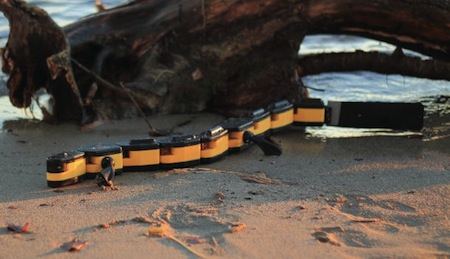Science Fiction
Dictionary
A B C D E F G H I J K L M N O P Q R S T U V W X Y Z
Salamandra Robotica II Crawls Onto Land

Take a look at this robotic amphibian from Switzerland.

(Robotic salamander)
Salamandra robotica II comes from the Biorobotics Laboratory at the École Polytechnique Fédérale de Lausanne technical university in Switzerland. Its ability to swim, crawl, and walk makes it unusual in the robotics world. For people with a fear of robots, that means there's nowhere to escape from it (unless you can fly).The amphibious robot uses a digital version of a spinal cord neural network to control its movements. It is helping researchers understand how salamanders are able to move and make the transition between water and land. Based on a video of Salamandra robotica II showing off its moves, I'd say the researchers have really nailed it. I don't think I'd want to unwittingly stumble on this thing emerging from the inky waters of the local pond.
SF writers have been enjoying the segmented crawly robots since the mining worm from Emmett McDowell's 1946 short story Love Among the Robots.
From CNET.
Scroll down for more stories in the same category. (Story submitted 3/25/2013)
Follow this kind of news @Technovelgy.| Email | RSS | Blog It | Stumble | del.icio.us | Digg | Reddit |
Would
you like to contribute a story tip?
It's easy:
Get the URL of the story, and the related sf author, and add
it here.
Comment/Join discussion ( 0 )
Related News Stories - (" Medical ")
BrainBridge Concept Transplant Of Human Head Proposed
'Briquet’s head seemed to think that to find and attach a new body to her head was as easy as to fit and sew a new dress.' - Alexander Belaev (1925)
Natural Gait With Prosthetic Connected To Nervous System
'The leg was to function, in a way, as a servo-mechanism operated by Larry’s brain...' - Charles Recour, 1949.
Brain Implant Is Able To Capture Your Inner Dialogue
'So you see, you can hide nothing from me.'
'Pregnancy Humanoids' From China Replace Moms
'A great many of these synthetic babies were made...' - David H. Keller, 1928.
Technovelgy (that's tech-novel-gee!) is devoted to the creative science inventions and ideas of sf authors. Look for the Invention Category that interests you, the Glossary, the Invention Timeline, or see what's New.
Science Fiction
Timeline
1600-1899
1900-1939
1940's 1950's
1960's 1970's
1980's 1990's
2000's 2010's
Current News
The Zapata Air Scooter Would Be Great In A Science Fiction Story
'Betty's slapdash style.'
Thermostabilized Wet Meat Product (NASA Prototype)
There are no orbiting Michelin stars. Yet.
Could Crystal Batteries Generate Power For Centuries?
'Power could be compressed thus into an inch-square cube of what looked like blue-white ice'
India Ponders Always-On Smartphone Location Tracking
'It is necessary... for your own protection.'
Amazon Will Send You Heinlein's Knockdown Cabin
'It's so light that you can set it up in five minutes by yourself...'
Is It Time To Forbid Human Driving?
'Heavy penalties... were to be applied to any one found driving manually-controlled machines.'
Replace The Smartphone With A Connected Edge Node For AI Inference
'Buy a Little Dingbat... electropen, wrist watch, pocketphone, pocket radio, billfold ... all in one.'
Artificial Skin For Robots Is Coming Right Along
'... an elastic, tinted material that had all the feel and appearance of human flesh and epidermis.'
Robot Guard Dog On Duty
I might also be thinking of K-9 from Doctor Who.
Wearable Artificial Fabric Muscles
'It is remarkable that the long leverages of their machines are in most cases actuated by a sort of sham musculature...'
BrainBridge Concept Transplant Of Human Head Proposed
'Briquet’s head seemed to think that to find and attach a new body to her head was as easy as to fit and sew a new dress.'
Google's Nano Banana Pro Presents Handwritten Math Solutions
'...copy was turned out in a charming and entirely feminine handwriting.'
Edible Meat-Like Fungus Like Barbara Hambly's Slunch?
'It was almost unheard of for slunch to spread that fast...'
Sunday Robotics 'Memo' Bot Has Unique Training Glove
'He then started hand movements of definite pattern...'
Woman Marries Computer, Vonnegut's Dream Comes True
'Men are made of protoplasm... Lasts forever.'
Natural Gait With Prosthetic Connected To Nervous System
'The leg was to function, in a way, as a servo-mechanism operated by Larry’s brain...'
